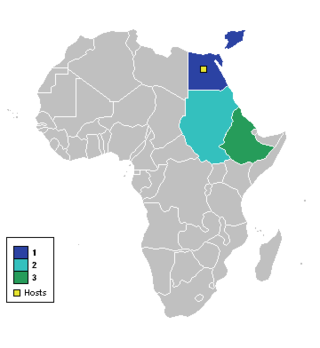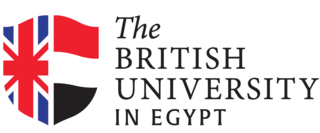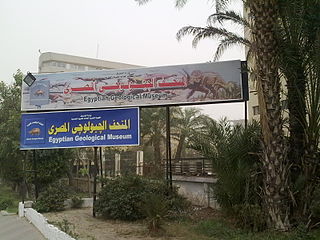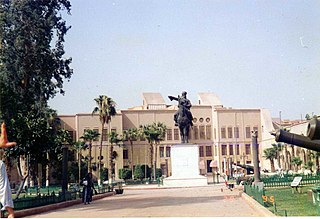
The Egyptian Air Force (EAF) (Arabic: القوات الجوية المصرية, romanized: El Qūwāt El Gawīyä El Maṣrīya), is the aviation branch of the Egyptian Armed Forces that is responsible for all airborne defence missions and operates all military aircraft, including those used in support of the Egyptian Army, Egyptian Navy and the Egyptian Air Defense Forces. The latter was created as a separate command in the 1970s and it coordinates with the Air Force to integrate air and ground-based air defense operations. The EAF is headed by an air marshal (lieutenant general equivalent). Currently, the commander of the Egyptian Air Force is Air Marshal Mahmoud Fouad Abdel-Gawad. The force's motto is 'Higher and higher for the sake of glory' (Arabic: إلى العلا في سبيل المجد, I‘la’ al-'olà fī sabīl al-magd). It was known as the Royal Egyptian Air Force until 18 June 1953 following the declaration of the Republic of Egypt by Muhammad Naguib.

Cairo Governorate is one of the 27 governorates of Egypt. It is formed of the city of Cairo, both the national capital of Egypt and the governorate's, in addition to five satellite cities: the New Administrative Capital - set to become the seat of national government, New Cairo, Shourok, Badr, Capital Gardens, and 15th of May. These cities form almost half of the Greater Cairo metropolitan area by population.

The 1959 African Cup of Nations was the second edition of the Africa Cup of Nations, the football championship between the national teams of Africa, organised by the Confederation of African Football (CAF). It was hosted and won by the United Arab Republic, a sovereign union between Egypt and Syria. Only three teams participated: host team United Arab Republic, Sudan, and Ethiopia. All three matches took place in Cairo.

The Cairo Opera House, part of Cairo's National Cultural Centre, is the main performing arts venue in the Egyptian capital. Home to most of Egypt's finest musical groups, it is located on the southern portion of Gezira Island in the Nile River, in the Zamalek district near downtown Cairo.

The Cairo International Stadium, formerly known as Nasser Stadium, is an Olympic-standard, multi-use stadium with an all-seated capacity of 75,000. The architect of the stadium is the German Werner March, who had built from 1934 to 1936 the Olympic Stadium in Berlin. The engineering and construction supervision work of the stadium was performed by ACE Moharram Bakhoum. It is the 69th largest stadium in the world. Located in Nasr City; a suburb north east of Cairo, it was completed in 1960, and was inaugurated by President Gamal Abd El Nasser on 23 July that year, the eighth anniversary of the Egyptian Revolution of 1952. Zamalek SC and Al Ahly use the stadium for most of their home games.

The British University in Egypt is a private Egyptian university in El Shorouk City, Cairo, Egypt. Founded in September 2005, through an inter-governmental agreement, it provides a British education style and awards degrees validated by its partner UK universities and the Egyptian Supreme Council of Universities.

The Headquarters of the Arab League is located in Tahrir Square and near the downtown business district of Cairo, Egypt. The headquarters building has views of the Nile River and Qasr al-Nil Bridge just to the west.

Zamalek is a qism (ward) within the West District in the Western Area of Cairo, Egypt. It is an affluent man-made island which geologically is part of the west bank of the Nile River, with the bahr al-a'ma cut during the second half of the 19th Century to separate it from the west bank proper. The northern third has been developed into a residential area, which was home to 14,946 people during the 2017 census. The southern two thirds are mostly sports grounds and public gardens, a stark green reserve in the middle of Cairo.

Bayt Al-Suhaymi is a Traditional Egyptian Islamic themed house and museum in Cairo, Egypt. It was originally built in 1648 by Abdel Wahab el Tablawy along the Darb al-Asfar, a very prestigious and expensive part of Islamic Cairo. In 1796 it was purchased by Sheikh Ahmed as-Suhaymi whose family held it for several subsequent generations. The Sheikh greatly extended the house from its original through incorporating neighbouring houses into its structure.

The Egyptian Geological Museum is a museum in Cairo, Egypt. The museum was established in 1901 as part of the Egyptian Geological Survey, which had been started in 1896 under the direction of the Khedive Ismail. The museum was the first of its kind in the Middle East and the African continent.

Downtown Cairo is the colloquial name given to the 19th-century western expansion of Egypt's capital Cairo, between the historic medieval Cairo, and the Nile, which became the commercial center of the city during the 20th century. Given its rich architectural heritage from the era of Khedive Ismail, it is has been officially named Khedival Cairo and declared by the government as a protected Area of Value, with many of its buildings also deemed protected. Administratively Wust al-Balad covers areas of qism Qasr al-Nil, and the Abdeen and Ezbekia districts. The protected Khedival Cairo covers a larger area extending south to Sayida Zeinab.

El Manial is a district of Cairo, located on Rhoda Island in the Nile.

The 30 June Stadium is a stadium used mostly for football matches and also sometimes for athletics located in Cairo. It was built by the Egyptian Air Defense Forces. The stadium is the main venue of the Air Defense Sport Village. The stadium has a capacity of 30,000 and it is one of the venues of the Egyptian Premier League. It is the home ground of the Egyptian Premier League side Pyramids F.C.

The Egyptian National Military Museum is the official museum of the Egyptian Army.

Al-Sayyida Nafisa Mosque or Mashhad al-Sayyida Nafisa is a mosque in al-Sayyida Nafisa district, a section of the larger historic necropolis called al-Qarafa in Cairo, Egypt. It is built to commemorate Sayyida Nafisa, an acclaimed Islamic scholar and member of the bayt (household) of the Islamic prophet Muhammad. The mosque has Sayyida Nafisa's mausoleum inside. Along with the necropolis around it, it is listed as part of the UNESCO World Heritage Site of Historic Cairo.

Sayyida Aisha Mosque is a mosque in Cairo, Egypt

Mosque of Qanibay al-Muhammadi is one of the historical mosques in Cairo, Egypt, built in 1413 CE during the Burji dynasty era of Mamluk Sultanate. It is located at Al-Saleeba street in Islamic Cairo, and there is Mosque and Khanqah of Shaykhu at its neighbor.
Europa-Schule Kairo (ESK) is a German international school in New Cairo, Cairo Governorate, Egypt.

The Hammam of Sultan Inal is a historic hammam in Cairo, Egypt. It is located in the Bayn al-Qasrayn area, on al-Mu'izz street, in the historic center of Cairo. The hammam was commissioned by Sultan Inal and built in 1456, during the Mamluk period. It is one of the few well-preserved hammams in Cairo out of the nearly 80 that existed by the end of the 19th century. It recently underwent a multi-year restoration and is now open to visitors as a historic monument.

















